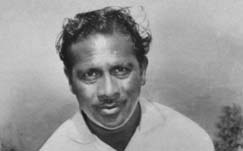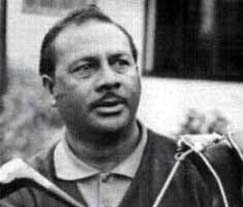Sporting greats
'Papwa' Sewgolum: little known great
No ordinary caddie
Although he was a better golfer than the men for whom he caddied, the racial laws of apartheid South Africa prevented him from demonstrating his prowess - even though, competing in non-white competition, he won the Natal Amateur at the age of 16. Sewgolum was "discovered" by a German, Graham Wulff, who lived in Howick in the Natal Midlands. Wulff was playing a round of golf with some colleagues one day when one of the men asked Sewgolum, who was caddying, which club he should use for an approach to the green. Sewgolum advised him to select either a six or seven iron. The man took his advice, but played a poor shot and took his frustration out on Sewgolum. Sewgolum didn't take kindly to the abuse; he put the man's bag down and began to walk away. Wulff called him back. He asked Sewgolum whether he would have used the same iron to reach the green. "Yes," the caddie replied. He then placed a ball - something the caddies were strictly forbidden to do - and knocked his approach to within half a metre of the pin.Dutch Open, Natal Open
Wulff was impressed. So much so that in 1959 he took Sewgolum overseas to play in the British Open. He was also due to play in Germany, but crossed lines in planning meant he missed out on that opportunity. Wulff then took him to the Netherlands to compete in the 1960 Dutch Open. Sewgolum won the tournament, successfully defended it the following year, became a three-time winner of the title in 1963, and finished as runner-up in 1964. Back in South Africa, Sewgolum was only allowed to compete from 1963. He promptly won the Natal Open, defeating Harold Henning - and becoming the first person of colour to win a professional golf tournament in South Africa. Henning was no slouch - he won more than 50 tournaments in his professional career, including victories in the US and Europe, and teamed up with Gary Player to win the World Cup Invitational in 1965.Beating Gary Player
As for Player, he was on a roll in 1965. Besides the World Cup Invitational, he won the US Open Championships to complete golf's Grand Slam of majors, took his third South African Open and fourth Australian Open, and notched up wins in the World Series, World Matchplay and NTL Challenge Cup. In the 1965 Natal Open, however, Player played second fiddle to Sewgolum. Sewgolum's second Natal Open victory was overshadowed, however, by the happenings at the prize-giving ceremony afterwards. Rain was pelting down, which prevented the trophy being presented outdoors, as was the usual case, and the ceremonies were moved inside. The laws of the day were that Indian people were not allowed inside the Durban Country Club. An infraction of those laws could have resulted in the club losing its liquor licence.International outcry
Photographs of Sewgolum receiving his Natal Open trophy in the rain - while the club's white patrons sat in comfort inside - flashed around the world, prompting an international outcry. A number of countries reacted by imposing sports sanctions on South Africa. In 1965, Sewgolum came within a whisker of winning the South African Open, losing out to Retief Waltman by a single shot. However, just when it seemed his career would take off, the apartheid government brought it to an appalling halt. In 1966 the government banned Sewgolum from all local tournaments, and by withdrawing his passport, prevented him from playing abroad - and, in effect, from making a living. Sewgolum died impoverished in 1978, not yet 50 years of age, from a heart attack.Belated recognition
In 2004, Sewgolum was posthumously awarded the Order of Ikhamanga, South Africa's highest honour for achievement in the performing arts and sport. Today, a golf course in Durban is named after him. The Papwa Sewgolum Municipal Golf Course is an 18-hole flat woodland course situated in the suburb of Reservoir Hills. In 2005, Wits University Press published Christopher Nicholson's biography Papwa Sewgolum: From Pariah to Legend. A documentary film about his life, "Papwa: The Lost Dream of a South African Golfing Legend", had its premiere in August 2005. Unveiling a memorial plaque in honour of Sewgolum earlier in 2005, Durban Country Club chairman Ray Lalouette described the 1965 Natal Open awards ceremony as "an ignominious débâcle that must have been the source of much embarassment and humiliation for a fellow human being at a time when he should have been experiencing joy and jubilation. "No matter what the background, or the rules of the land, it must have been an experience that caused hurt and shame for him and his family. "It is therefore fitting and appropriate that I, as the current chairman, take this opportunity on behalf of the members of the Durban Country Club, to apologise to Mrs Suminthra Sewgolum and to Mr Sewgolum's son, Rajen, and his family for the suffering you have endured as a result of that most unfortunate incident. "We have commissioned this plaque to serve as a permanent reminder to all those (and especially golfers) who walk this way, that 'Papwa' Sewgolum was a remarkable man."
Would you like to use this article in your publication or on your website? See: Using SAinfo material

Papwa Sewgolum, had he been given the opportunity, could have well become a great of the golfing world (Photo: The Ottawa Citizen)

''Papwa'' Sewgolum in his later years. The three-time Dutch Open champion and two-time Natal Open champion was good enough to beat a Gary Player at the top of his game ... far too good for an Indian under apartheid (Photo: Gandhi-Luthuli Documentation Centre, University of KwaZulu-Natal)



 'Papwa' Sewgolum in his prime (Photo:
'Papwa' Sewgolum in his prime (Photo: 
